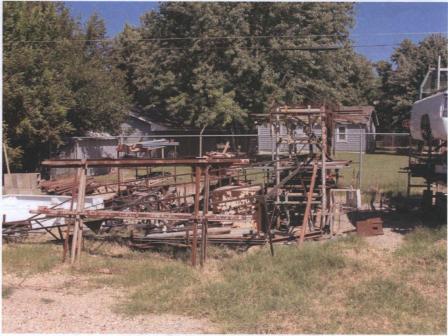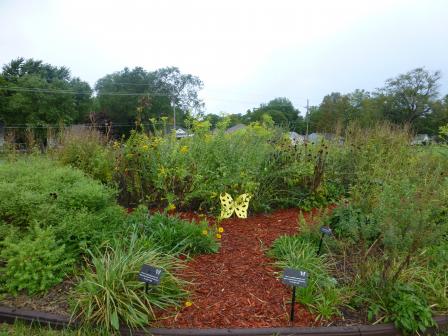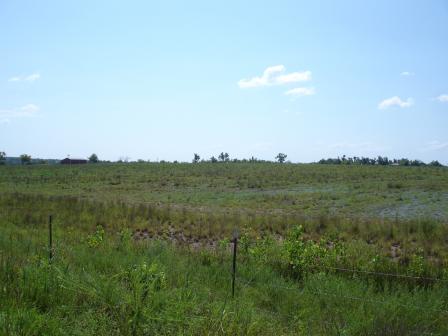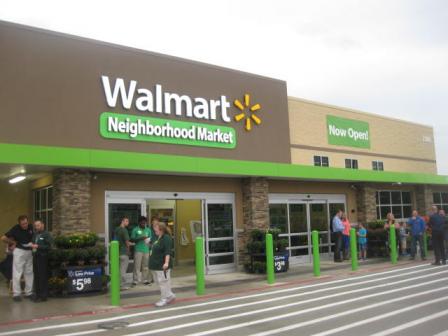Superfund Sites in Reuse in Kansas
If you are having trouble viewing the map in your browser, click the 'View larger map' link below
57th and North Broadway Streets Site
 57th and North Broadway Streets SiteThe 57th and North Broadway Streets Superfund site includes residential, industrial and commercial areas in Wichita, Kansas. Nearby businesses include an oil refining plant, trucking company, abandoned gas station and abandoned paint factory. Past activities at businesses near the site contaminated site groundwater and soil. EPA placed the site on the Superfund program's National Priorities List (NPL) in 1992. After further site investigation, the ongoing cleanup plan selected by EPA better addresses the site contamination. EPA’s cleanup plan allowed the continued residential, public, industrial and commercial use of the site. These uses include many single family residences, a used oil re-refinery, trucking firms, a municipal waste water treatment plant, an insurance impound lot, a school bus facility and other small business and agricultural uses. A new remedy for the site is in progress and currently in the feasibility study phase, groundwater monitoring continues at the site.
57th and North Broadway Streets SiteThe 57th and North Broadway Streets Superfund site includes residential, industrial and commercial areas in Wichita, Kansas. Nearby businesses include an oil refining plant, trucking company, abandoned gas station and abandoned paint factory. Past activities at businesses near the site contaminated site groundwater and soil. EPA placed the site on the Superfund program's National Priorities List (NPL) in 1992. After further site investigation, the ongoing cleanup plan selected by EPA better addresses the site contamination. EPA’s cleanup plan allowed the continued residential, public, industrial and commercial use of the site. These uses include many single family residences, a used oil re-refinery, trucking firms, a municipal waste water treatment plant, an insurance impound lot, a school bus facility and other small business and agricultural uses. A new remedy for the site is in progress and currently in the feasibility study phase, groundwater monitoring continues at the site.
For more information:
Big River Sand Co.
The 123-acre Big River Sand Co. Superfund site is a former sand and gravel mining operation located in Wichita, Kansas. During the 1970s, site operators disposed of drums of paint-related waste on the site next to a sand quarry lake. In 1978, the Big River Sand Company bought 80 acres of the site property. The state of Kansas led an investigation in 1982 that confirmed that many of the drums on site were damaged, corroded and leaking. Further studies found solvents and heavy metals in nearby residential wells in 1982 and 1984. From 1982 to 1984, the state provided oversight of the removal and cleanup activities performed by the property owner. EPA placed the site on the Superfund program's National Priorities List (NPL) in 1986. In 1988, a Record of Decision determined No Further Action was required for soil and groundwater cleanup. EPA deleted the site from the NPL in 1992. Currently, a sand quarry and junkyard operate on the site.
For more information:
Chemical Commodities, Inc.
 Chemical CommoditiesThe Chemical Commodities, Inc. (CCI) Superfund site is located in Olathe, Kansas. CCI was a chemical brokerage facility that conducted recycling activities that often spilled or leaked hazardous chemicals. Other on-site companies performed chemical repackaging and storage activities. CCI stored chemicals of all types on the property in aboveground and underground storage tanks and drums. Nearby residents reported many fires and explosions at the site during the 1960s and 1970s. EPA added the site to the Superfund program’s National Priorities List (NPL) in 1994. Cleanup activities included removing and disposing of contaminated soil, putting land use controls in place, treating and managing groundwater contamination, and maintaining a vapor control system. The potentially responsible parties worked with EPA and other organizations to develop a walk-through educational natural habitat for Monarch butterflies on the site. Participating organizations include two outreach programs: Monarch Watch, which is focused on education, research and conservation of monarch butterflies and the Pollinator Partnership, which promotes the health of pollinators, critical to food and ecosystems, through conservation, education, and research. Also, Monarch Joint Venture, a partnership of federal and state agencies, non-governmental organizations, and academic programs working together to support and coordinate efforts to protect the monarch migration across the lower 48 United States; Wildlife Habitat Council, a nonprofit, non-lobbying group of corporations, conservation organizations and individuals dedicated to restoring and enhancing wildlife habitat, protecting biodiversity and educating communities; and the CCI Community Advisory Group coordinated to develop the habitat. The site includes habitat for birds, bees and butterflies; a tagging station for migrating butterflies; and informational kiosks along a walking trail. An October 2012 ribbon-cutting ceremony formally opened the former CCI Superfund site as the new Pollinator Prairie. The site provides a beautified landscape for the surrounding neighborhood and offers the local community an educational opportunity to learn the importance of pollination.
Chemical CommoditiesThe Chemical Commodities, Inc. (CCI) Superfund site is located in Olathe, Kansas. CCI was a chemical brokerage facility that conducted recycling activities that often spilled or leaked hazardous chemicals. Other on-site companies performed chemical repackaging and storage activities. CCI stored chemicals of all types on the property in aboveground and underground storage tanks and drums. Nearby residents reported many fires and explosions at the site during the 1960s and 1970s. EPA added the site to the Superfund program’s National Priorities List (NPL) in 1994. Cleanup activities included removing and disposing of contaminated soil, putting land use controls in place, treating and managing groundwater contamination, and maintaining a vapor control system. The potentially responsible parties worked with EPA and other organizations to develop a walk-through educational natural habitat for Monarch butterflies on the site. Participating organizations include two outreach programs: Monarch Watch, which is focused on education, research and conservation of monarch butterflies and the Pollinator Partnership, which promotes the health of pollinators, critical to food and ecosystems, through conservation, education, and research. Also, Monarch Joint Venture, a partnership of federal and state agencies, non-governmental organizations, and academic programs working together to support and coordinate efforts to protect the monarch migration across the lower 48 United States; Wildlife Habitat Council, a nonprofit, non-lobbying group of corporations, conservation organizations and individuals dedicated to restoring and enhancing wildlife habitat, protecting biodiversity and educating communities; and the CCI Community Advisory Group coordinated to develop the habitat. The site includes habitat for birds, bees and butterflies; a tagging station for migrating butterflies; and informational kiosks along a walking trail. An October 2012 ribbon-cutting ceremony formally opened the former CCI Superfund site as the new Pollinator Prairie. The site provides a beautified landscape for the surrounding neighborhood and offers the local community an educational opportunity to learn the importance of pollination.
For more information:
- Buzzing with Life: Environmental Education and Stewardship. The Chemical Commodities, Inc. Superfund Site in Olathe, Kansas (PDF)(18 pp, 2.2 MB, About PDF)
- News Release: EPA Recognizes Boeing for Leadership in Revitalization at CCI, Inc. Superfund Site, Olathe, Kan.
- Video: Plants, People, Pollinators: Environmental Education and Stewardship Chemical Commodities, Inc. Superfund Site in Olathe, Kansas Exit
- Superfund Site Profile Page
Cherokee County
 Cherokee CountyNative grasses, streams and wildlife have replaced barren rock and gravel at the Cherokee County Superfund site in Cherokee County, Kansas. One hundred years of lead and zinc mining left the land strewn with contaminated debris and soil that caused contamination of area groundwater. EPA added the site to the Superfund program’s National Priorities List (NPL) in 1983. In 1993, after ensuring that area residents with private wells had safe drinking water, EPA gathered surface mine wastes and buried them on site. Workers covered land with clean soil, diverted streams to avoid the stored wastes and planted the entire site with native vegetation. In 2009, the site received $14.5 million in American Reinvestment and Recovery Act (ARRA) funds, which EPA is using to support cleanup activities at the Badger, Lawton, Baxter Springs and Treece sub-sites. The ARRA funding will enable EPA to complete the project in fewer years than originally anticipated. Today, EPA cleanup has restored a 25 square-mile portion of the 115 square-mile site as a wildlife habitat. Restoration efforts continue. Cleanup of this site has restored the delicate natural environment and reduced human health risks from contamination.
Cherokee CountyNative grasses, streams and wildlife have replaced barren rock and gravel at the Cherokee County Superfund site in Cherokee County, Kansas. One hundred years of lead and zinc mining left the land strewn with contaminated debris and soil that caused contamination of area groundwater. EPA added the site to the Superfund program’s National Priorities List (NPL) in 1983. In 1993, after ensuring that area residents with private wells had safe drinking water, EPA gathered surface mine wastes and buried them on site. Workers covered land with clean soil, diverted streams to avoid the stored wastes and planted the entire site with native vegetation. In 2009, the site received $14.5 million in American Reinvestment and Recovery Act (ARRA) funds, which EPA is using to support cleanup activities at the Badger, Lawton, Baxter Springs and Treece sub-sites. The ARRA funding will enable EPA to complete the project in fewer years than originally anticipated. Today, EPA cleanup has restored a 25 square-mile portion of the 115 square-mile site as a wildlife habitat. Restoration efforts continue. Cleanup of this site has restored the delicate natural environment and reduced human health risks from contamination.
For more information:
- Cherokee County, Cherokee County, KS - Reuse Plan (PDF) (17 pp, 1.7 MB, About PDF)
- Superfund Site Profile Page
Kansas City Structural Steel
 Kansas City Structural SteelCompanies smelted silver ore and made steel products at the 22-acre Kansas City Structural Steel site for more than a century. Industrial activities from the steel plant contaminated soil with heavy metals, including lead. Site cleanup took place from 1990 to 1995. Under EPA oversight, the site’s potentially responsible party performed cleanup activities. The site is located close to roads in a commercial and residential area. El Centro, a local nonprofit organization signed an agreement with EPA to ensure the site remedy would remain protective in the long term. This allowed El Centro to purchase the site property in 1995. El Centro’s mission is “strengthening communities and improving lives of Latinos and others through educational, social, and economic opportunities.” In 2013, the Lane4 Property Group approached El Centro, neighborhood leaders and EPA with plans to develop a grocery and retail center at the site. The Lane4 Property Group broke ground on the “La Plaza Argentine” shopping center in March 2014. On September 10, 2014, EPA Regional Administrator Karl Brooks presented the Leading Environmentalism and Forwarding Sustainability (LEAFS) award to Walmart and to the Argentine Neighborhood Development Association for creating the new Walmart Neighborhood Market. Site stakeholders are considering additional reuses at the site.
Kansas City Structural SteelCompanies smelted silver ore and made steel products at the 22-acre Kansas City Structural Steel site for more than a century. Industrial activities from the steel plant contaminated soil with heavy metals, including lead. Site cleanup took place from 1990 to 1995. Under EPA oversight, the site’s potentially responsible party performed cleanup activities. The site is located close to roads in a commercial and residential area. El Centro, a local nonprofit organization signed an agreement with EPA to ensure the site remedy would remain protective in the long term. This allowed El Centro to purchase the site property in 1995. El Centro’s mission is “strengthening communities and improving lives of Latinos and others through educational, social, and economic opportunities.” In 2013, the Lane4 Property Group approached El Centro, neighborhood leaders and EPA with plans to develop a grocery and retail center at the site. The Lane4 Property Group broke ground on the “La Plaza Argentine” shopping center in March 2014. On September 10, 2014, EPA Regional Administrator Karl Brooks presented the Leading Environmentalism and Forwarding Sustainability (LEAFS) award to Walmart and to the Argentine Neighborhood Development Association for creating the new Walmart Neighborhood Market. Site stakeholders are considering additional reuses at the site.
For more information:
- Reuse and the Benefit to Community: Kansas City Structural Steel Case Study (2015) (PDF)(9 pp, 2 MB, About PDF)
- Redevelopment of the Kansas City Structural Steel Superfund Site (PDF) (1 pg, 384K)
- A New Community Gateway: Commercial Redevelopment at a Former Smelter - Kansas City Structural Steel Site in Kansas City, Kansas(12 pp, 6 MB)
- News Release: Kansas City Structural Steel Superfund Site in Kansas City, Kan., Set for Redevelopment
- Superfund Site Profile Page
Strother Field Industrial Park
The 2-square-mile Strother Field Industrial Park Superfund site is located near Winfield and Arkansas City, Kansas. Until 1946, the site operated as a military facility for aircraft construction and maintenance. The U.S. Army's use of site was typical of a military air base, including aircraft maintenance and support, housing and barracks, and related personnel facilities. Site operators disposed of various industrial wastes in two on-site landfills. In 1982, the Kansas Department of Health and Environment detected dissolved organic solvents in water supply wells at the site during an on-site survey. Further site investigations showed site-wide soil and groundwater contamination due to previous on-site operations. EPA issued a cleanup plan in 1994. This plan included groundwater extraction and treatment and monitoring of the natural breakdown processes to clean up groundwater. EPA also capped two areas with concrete to help prevent the movement of precipitation and surface water runoff through area soils. The site now consists of several industrial and commercial businesses, as well as two inactive solid waste landfills. Much of the land remains undeveloped.
For more information:
- Reuse and the Benefit to Community: Strother Field Industrial Park Case Study (2015) (PDF)(12 pp, 1.4 MB, About PDF)
- Superfund Site Profile Page
Wright Ground Water Contamination
The Wright Ground Water Contamination Superfund site is located in Wright, Kansas. In 1988, sampling from a private well showed contamination at the site. The person who collected the sample notified the Kansas Department of Health and Environment (KDHE) after discovering pesticides, heavy metals and volatile organic compounds (VOCs) in the groundwater sample. KDHE conducted further sampling in wells throughout Wright, confirming area-wide groundwater contamination. Since the City of Wright did not have a municipal water supply, all residents received water from private wells. EPA added the site to the Superfund program’s National Priorities List (NPL) in 1996. A 1997 EPA removal action provided a municipal water line for the citizens of Wright. EPA issued a cleanup plan in 2007 that included monitoring of natural processes to clean up groundwater contamination and land use controls. Residential, commercial and agricultural uses continue on the site.
For more information:
